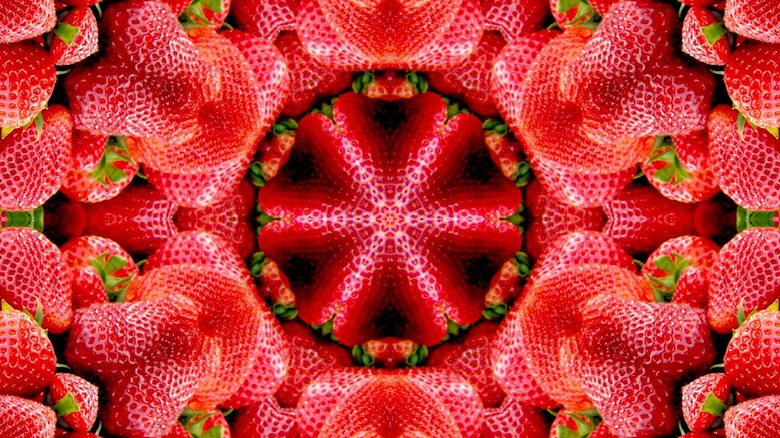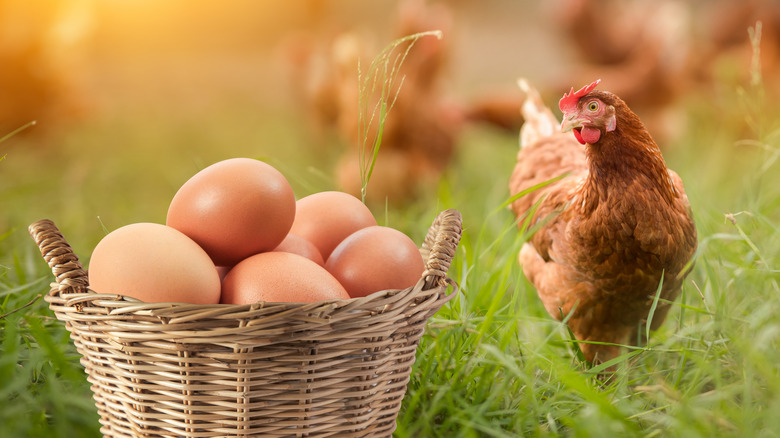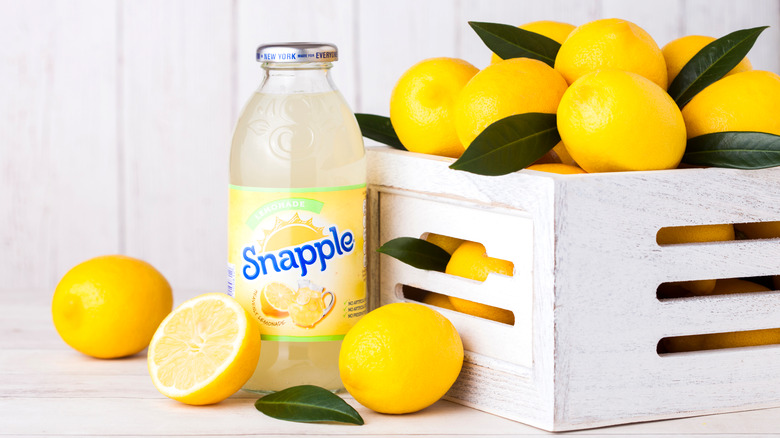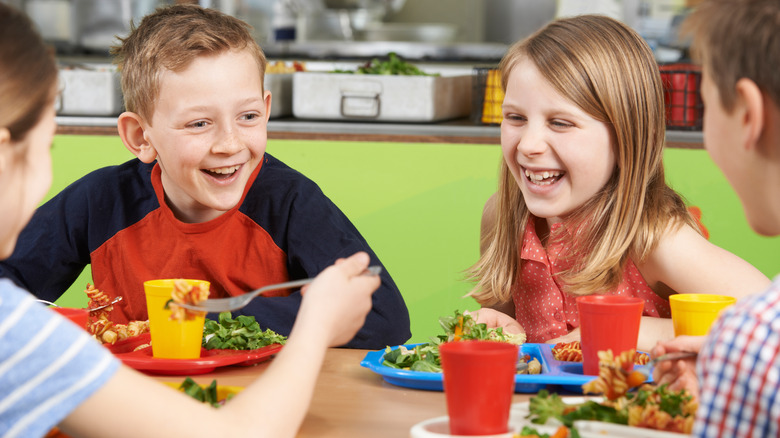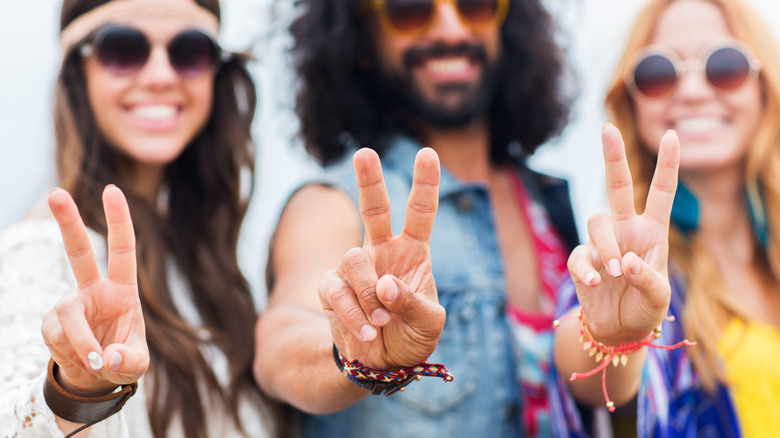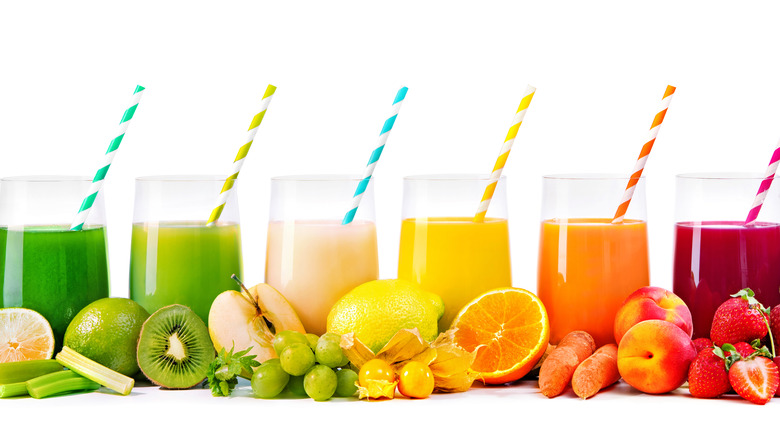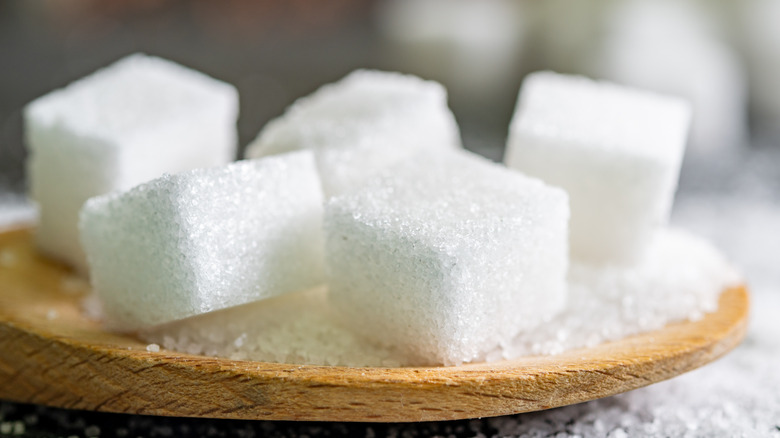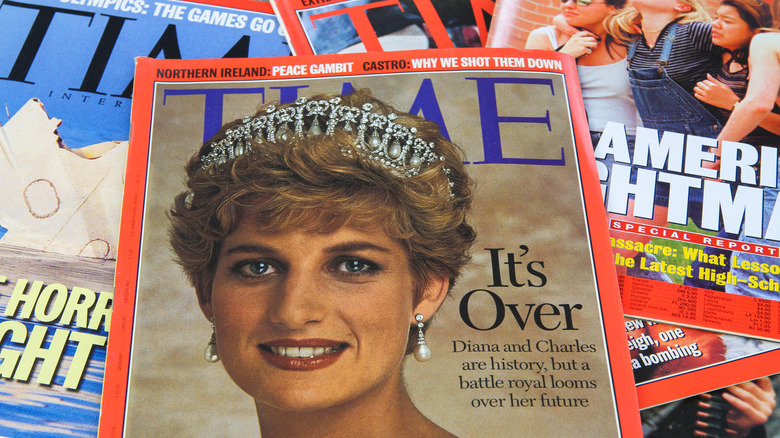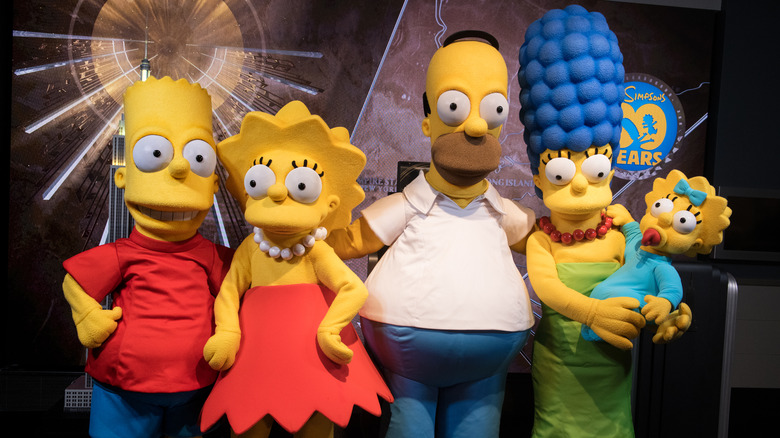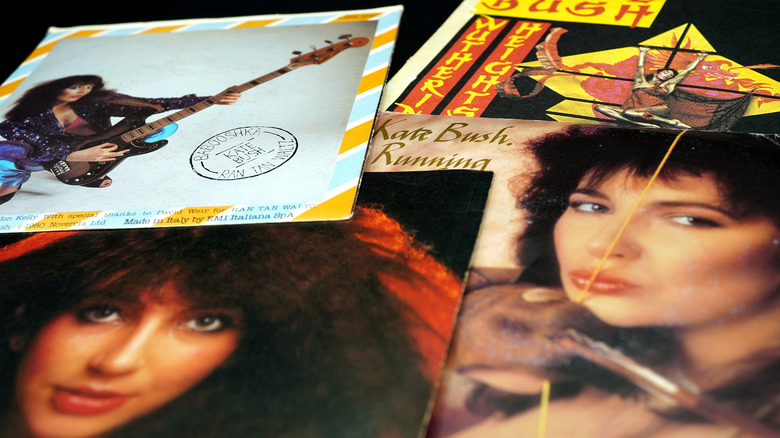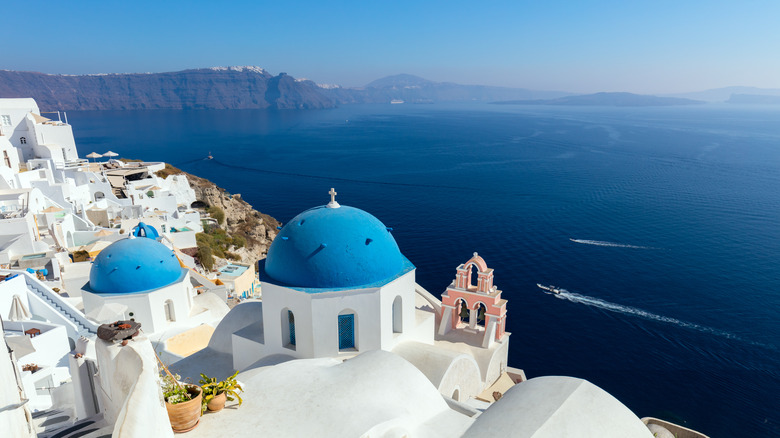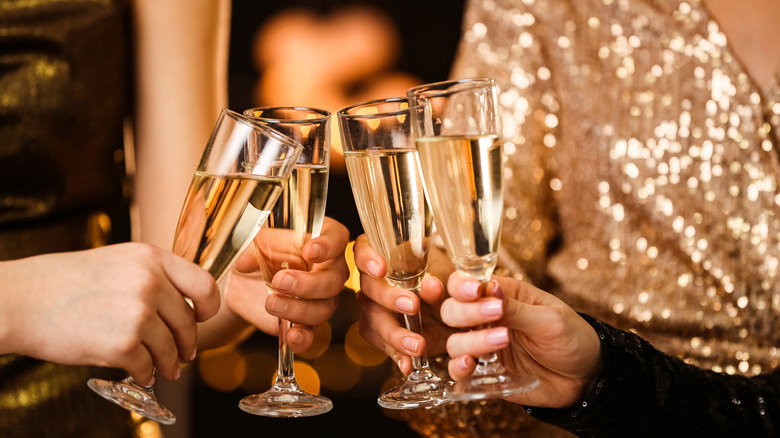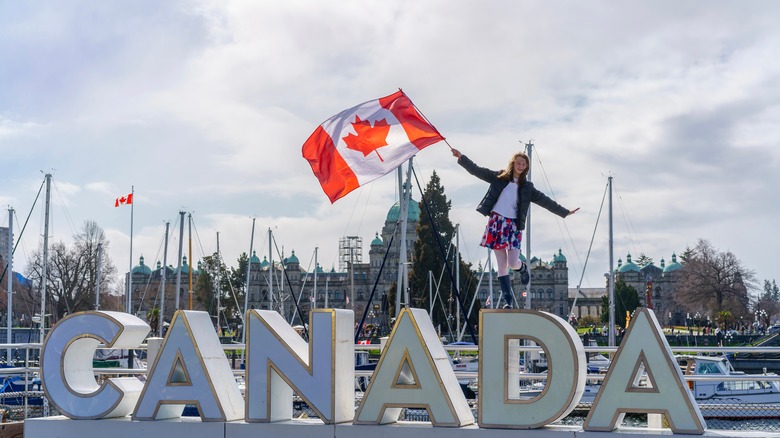The Untold Truth Of Fruitopia
Few things will instantly flip the on switch when it comes to 90s snack nostalgia like the magic, the mystery that was Fruitopia. What school wasn't home to one of their psychedelic, vividly colored vending machines, stocked with things like Strawberry Passion Awareness, Blueberry Watermelon Wisdom, and Fruit Integration (Coca-Cola)? What's more, Fruitopia wasn't just a uniquely flavored bottled beverage. It was a state of mind, man. Coca-Cola's chief marketing officer at the time, Sergio Zyman, designed it to be so. If you can make a product part of someone's self-image, you have got a hit ... Right?
After launching in 1994, the future of Fruitopia seemed bright. So what happened? What made it such an inextricable part of youth culture in the 90s? Most importantly, is it still available for purchase today? Strap in, and ready yourself for a trippy trip down Sentimental Street.
Coca-Cola was trying to keep its eggs in different baskets
Everyone knows the old adage, "don't put all of your eggs in one basket." It means that diversification is the key to weathering tough times. If one basket falls, and the eggs inside break, there are still other eggs to draw on, so it's less of a tragedy.
In the 1990s, non-carbonated soft drinks in the United States were quickly on the rise and spelled big business (New York Times). Coca-Cola was not about to let that opportunity pass by. Not only did Coca-Cola introduce their fruit-flavored Fruitopia in 1994, but by the end of the year, they were investing a further $150 million to enlarge the brand's selection, including offering a lower-calorie line. Existing bottling factories were upgraded and additional factories were bought in Massachusetts and Texas.
At the time, this move just made sense. The so-called alternative beverage market (alternative to carbonated beverages and alcohol) was $6 billion strong (Los Angeles Times).
Fruitopia was specifically designed to compete with Snapple
Snapple launched in 1972 and came out with its bottled lemon iced tea in 1987. The juice and tea brand became so successful that the Snapple Beverage Corporation was purchased by the Quaker Oats Company in 1994 for $1.7 billion despite floundering sales and a hit to their stock prices. And 1994 is when Coca-Cola came snapping at their heels with Fruitopia.
Fruitopia was invented by Coca-Cola to compete directly with Snapple, full stop. The New York Times included this claim frequently in their articles on the brand, and it was no secret. Beverage industry analyst Emanuel Goldman (in the New York Times) flat out called Fruitopia "basically a Snapple knock-off." The big wigs at Coca-Cola knew that the beverage market was changing. Growths in the carbonated beverage market had slowed considerably in recent years (New York Times). Seeing opportunity in the rising popularity of Snapple, they wanted a piece.
It was an essential part of a well-balanced 90s school lunch
Even though many have forgotten it existed, in the 90s, Fruitopia took middle and high schools by storm (Atlas Obscura). Practically every campus had a Fruitopia vending machine. One user on Reddit even claimed this was the only vending machine their school had, and when lunchtime came around, students lined up to buy a bottle. It was also a beloved staple of many students' lunch boxes.
Fruitopia was unabashedly targeted at teenagers and kids. The colors were bright. The names were trippy. And it dyed your tongue different colors depending on the flavor. Teenagers were hired to tour the United States in psychedelic buses to pass out free bottles.
Fruitopia vending machines also popped up on college campuses and in dormitories, where it was not always used for the most innocent of reasons. As pointed out by one Redditor, the bright colors and fruity flavors of the liquid made it easy to conceal alcohol. Another Redditer freely admitted the Fruitopia available in their dorm was often used as a mixer.
Fruitopia was an emblem of the New Age (90s style)
With the year 2000 fast approaching, there was a surge in interest in the New Age, which usually went hand-in-hand with things like peace, love, and harmony. No, these ideas did not end with 1960s counter-culture. Besides, by the 1990s those hippies had grown up and were raising Gen X and Millennials, both of whom sat squarely in the middle of Fruitopia's crosshairs.
Beverages like Snapple and Fruitopia were an extension of this New Age aesthetic. Tea was no longer just tea, and juice was no longer, well, juice (see below). Fruitopia ads often incorporated a psychedelic kaleidoscope of fruit. There were flavors like Strawberry Passion Awareness and Lemonade Love and Hope. In terms of drink choices, it didn't get more New Age than that.
But even as the new soft drink was making its first big splash, people were predicting its downfall and the end of the New Age beverage scene altogether.
It was only about 17% juice
It's a good thing Fruitopia never quite advertised itself as juice because it really wasn't. Depending on the flavor, a bottle might contain an average of 17% juice, but it was mostly flavored — and vividly colored — sugar water.
Fruitopia was an extremely fruit-forward beverage. Not only was fruit in the brand name, most of the flavor names (strawberry, orange, et cetera), and the unforgettable kaleidoscopes of the early TV ads, but later 90s ads assured consumers they "put the fruit in Fruitopia" (YouTube). Luckily, the fruit was not there to be nutritious but to "make you feel good."
Fruitopia was a fruit drink, not a fruit juice. The difference is that fruit juice is squeezed from fresh fruit. Fruit drinks or fruit beverages are not, even ones claiming to be "made with real fruit." Fruit juice also naturally contains vitamins and minerals. Any vitamins in a fruit drink must be added.
There's a surprising amount of vitamin C ... and a lot of sugar
As mentioned above, vitamins needed to be added to this tasty sugar water for them to exist, and a surprising amount was of vitamin c was added, specifically. A serving of McDonald's Orange Groove, for example, offers 114 milligrams or 190% daily recommended value. There are no other vitamins or minerals listed on Fruitopia's nutritional summary. There are, however, 46 grams of sugar.
According to the "Dietary Guidelines for America" (per the FDA), the amount of added sugar, or sugar that is not naturally occurring in the food but is added in the assembly process, in one's diet should not exceed 10% of calories consumed. So if a person regularly consumes 2,000 calories in one day, no more than 200 should come from added sugars, or about 50 grams, to maintain a healthy diet. After just one serving of Fruitopia, you are left with a mere 4 grams of sugar left in your day.
It made Time Magazine's Best Products of 1994
On December 26th, 1994, Time Magazine released its list of the Best Products of 1994. The range of winners was broad, from the revolutionary internet browser Netscape to the uplifting Wonderbra. And who can forget the adorable Chrysler Neon?
Also appearing on that list was Fruitopia. Time highlighted the unique advertising campaign as well as the New Age flavor names. They also pointed out that, in less than a year, Fruitopia was able to snatch a good chunk of the non-carbonated beverage market. It was as exciting as the release of Donkey Kong Country! The playing of which was probably accompanied by the chugging of many a bottle of Fruitopia.
Fruitopia was the only food or beverage item to make the list that year. Given that it was created as a direct competitor of Snapple, was it really as innovative as the Sony Magic Link or Seiko Message Watch? It's a matter of taste.
Stephen Hawking used it as a sick burn on The Simpsons
"The Simpsons," like most sitcoms, is a TV show that often relies on popular culture for its jokes and episode plotlines. Is it any wonder, then, that Fruitopia found its way into this animated world during the 90s?
In the episode "They Saved Lisa's Brain," which first aired on May 9, 1999, none other than theoretical physicist Stephen Hawking invoked the quirky Coca-Cola beverage. (Yes, it was really him.) After Mayor Quimby leaves town, the most intelligent citizens of Springfield (members of the local chapter of MENSA) take over, passing various laws in an attempt to create the perfect community.
But, people being people, disharmony ensues, and during an argument at a public town meeting, Stephen Hawking swoops in to save the day. It is then that he utters the famous line, "I wanted to see your utopia, but now I see it is more of a fruitopia."
Award-winning musician Kate Bush wrote music for the ads
When Kate Bush was 19 years old in 1978, she became the first woman to top the U.K. Singles Chart with a self-written song (Awards & Winners). She is an award-winning singer-songwriter, musician, and music producer with a career spanning five decades. Why would a musical artist of her caliber agree to write original scores for an untried soft drink's advertising campaign, even one backed by the powerhouse of Coca-Cola? It's a question people have been asking since the first Fruitopia ad backed by a Kate Bush soundtrack hit the screens in 1994, and no one yet has a definitive answer. Maybe she just liked the concept.
Perhaps you remember the hypnotic kaleidoscope of fruit and other images of nature that played in theaters as a pre-film advertisement in 1995 (YouTube). Maybe that song has even lived somewhere inside your brain ever since. Bush's music is at least as iconic as the imagery. Fruitopia wouldn't be the same without her.
Coca-Cola was involved in a legal battle in Greece over the name
When the Coca-Cola company attempted to introduce its Fruitopia line to Greece, they ran into a little legal trouble. There was already a Fruitopia in Greece, a TV series and comic-strip by beloved children's book author and criminologist (yes, really) Eugene Trivizas. Trivizas was, understandably, not thrilled about this multinational corporation moving in on his territory.
Trivizas won his legal battle against Coca-Cola in 1997 after the court decided that his intellectual property had indeed been appropriated unlawfully. This prevented Coca-Cola from registering Fruitopia as their own trademark in Greece. Naturally, Coca-Cola appealed the ruling, but again things did not go their way, and the court of appeals upheld Trivizas's claim to the Fruitopia name. As a result, Coca-Cola was not allowed to sell Fruitopia in Greek markets (Snack History).
Trivizas wanted to pursue his case internationally, but there's no word on how that turned out for him.
Fruitopia entered the new millennium on a high note
Despite the blemish of ultimately losing the lawsuit to Trivizas in Greece, Coca-Cola and Fruitopia had a great 1999, departing the 20th century with strong sales. 44 million cases of Fruitopia had been sold that year, the highest number yet.
Sadly, this would also prove to be the highest sales would ever be. Just three years later, only 19 million cases were sold. That is one swift decline, but it was a new millennium, the target audience of the 90s was growing up, and tastes were changing. More lawsuits over the ethicality and lawfulness of exclusivity deals did not help matters.
Funnily enough, Fruitopia was competing directly with its fellow Minute Maid beverages, and that is where Coca-Cola decided to send the more popular Fruitopia flavors in the U.S. when finally throwing in the tie-dyed towel in 2003, albeit under more conventional names. Executives at Coca-Cola believed that Minute Maid had more staying power as a brand than Fruitopia, and it turns out they were right.
You can still buy it in Canada
That's right. While we have been referring to Fruitopia in the past tense and lamenting its loss, that is only true for most of us. Canadian readers may have been wondering what the heck we were talking about, and rightly so. Coca-Cola Canada still manufactures and markets Fruitopia in both cartons and cans.
One Reddit user said that during a trip to Canada, they were able to get Strawberry Passion Awareness from most Coca-Cola beverage fountains. McDonald's also serves Orange Groove in Canada, which is unique to it. Other flavors you can purchase in stores are Tangerine Wavelength, Blueberry Watermelon Wisdom, Raspberry Kiwi Karma, and Fruit Integration. The packages are just as vibrant and colorful as they ever were.
If you aren't within easy access of the land of maple and moose to quench your cravings, you might be able to find someone to barter with on Reddit.
